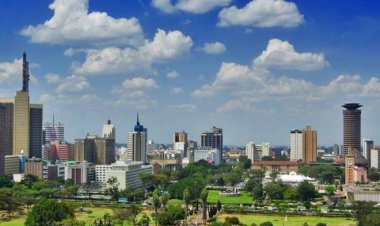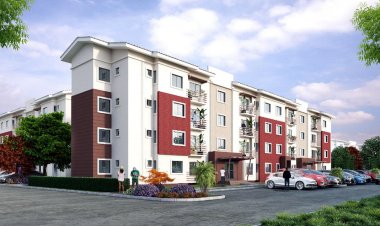Kenya's Affordable Housing Initiatives: Progress, Challenges, and Future Strategies Explored
The National Housing Fund offers numerous benefits in terms of addressing the housing supply and demand gap, making it a sustainable solution.

Access to adequate and affordable housing is a basic human need. According to Article 43 of the Kenyan Constitution, everyone has the right to accessible and adequate housing.
The Kenya Vision 2030 recognizes the development of quality and affordable housing for low-income Kenyans as a priority within its social pillar.
Additionally, the government aims to bridge the housing gap by facilitating the construction of 250,000 houses per year through the Bottom-Up Economic Transformation Agenda.
As of 2019, Kenya's population was 47.5 million, with 31% residing in urban areas. Although the majority still live in rural areas, urbanization is expected to continue, with an estimated 50% of the population living in urban areas by 2050.
Listen to the latest episode of the African Real Estate Podcast here: https://shorturl.at/kuDY6
Homeownership rates vary across counties, with Nairobi and Mombasa having a high proportion of rented houses, while Migori, Homa Bay, and West Pokot have over 80% home ownership. As a result, households in Nairobi and Mombasa spend a significant portion of their income on rent.
The National government has shown its commitment to improving housing conditions through housing development and human settlement programs.
Between 2018 and 2022, the government allocated 125 billion shillings to the housing sector, with the goal of implementing the Affordable Housing Program (AHP). However, the AHP, which is part of the "Big Four" agenda, fell short of its target of 500,000 units, with less than 10% being delivered by 2022.
To encourage the growth of affordable housing and bridge the supply-demand gap, the government introduced incentives. These incentives include a stamp duty exemption for first-time homebuyers, a 15% housing relief on employee contributions, and an exemption of value-added tax (VAT) on imported and locally purchased construction materials for affordable homes. However, despite these incentives, accessibility and affordability issues still persist.
The Finance Act 2023 introduced a housing levy equivalent to 1.5% of employees' basic salary, paid by both the employee and the employer. These funds are intended for the development of affordable housing and associated infrastructure, such as power, water, and sanitation facilities.
The objective of this blog is to explore approaches to achieving affordable housing. Lessons will be drawn from successful economies such as Singapore, where over 80% of the population lives in affordable housing.
Housing Intervention and Gaps: The Affordable Housing Program (AHP), introduced in 2017 as part of the "Big Four" agenda, outlines the policy framework for affordable housing. The AHP Development Framework Guideline 2018 specifies the measures for implementing the AHP, which focuses on both the supply and demand sides of housing.
To promote the construction of affordable housing and meet the needs of low- and middle-income individuals, the Housing Act Cap 117 establishes a Housing Fund managed by the National Housing Corporation (NHC). The Housing Fund acts as a bridge between the demand for affordable homes and private developers. The National Housing Development Fund Regulations, 2020 provide eligibility and allocation criteria for affordable housing schemes.
To facilitate the implementation of the AHP, the government has set up three key entities. The Boma Yangu portal promotes transparency and simplifies tracking the program's progress.
The Kenya Mortgage Refinance Company (KMRC) collaborates with Primary Mortgage Lenders, such as banks and savings and cooperative societies (SACCOs), to offer home loans to potential buyers. The National Housing Corporation (NHC) oversees policy implementation and project development.
The NHC continues to support decent housing through various initiatives, including tenant purchase, outright sale, rural and peri-urban housing loans, and rental housing. However, additional innovation is necessary to reduce construction costs and achieve affordable prices and rent.
The AHP's target beneficiaries are divided into three income segments: social (Ksh 0-19,999), low-cost (Ksh 20,000-49,999), and mortgage gap (Ksh 50,000-149,999). The NHC Strategic Plan outlines financing options for individuals in rural and peri-urban areas. It also offers a 7.0% interest rate cap for financing individual housing initiatives.
Mortgage gap buyers can obtain affordable mortgages through the open market, with assistance from the Kenya Mortgage Financing Corporation. Social and low-cost buyers are eligible for the Tenant Purchase Scheme (TPS) with a 3.0% - 7.0% interest rate, payable over 25 years.
An important aspect of the AHP is the recognition that land is essential infrastructure for affordable housing supply. The government intends to provide serviced land to private developers through public-private partnerships (PPPs) to encourage the construction of affordable homes.
Additionally, the government will develop necessary infrastructure, such as water, sewage systems, access roads, and power, to attract private sector involvement. Developers can benefit from the Housing Fund, as it provides a substantial amount of money that is consistently contributed and protected by law.
The process involves developers completing the construction of housing units and delivering them to the NHDF. In return, the Housing Fund reimburses the builders for the completed units and enters into tenant purchase contracts with members for the finished homes.
Members then make affordable monthly installments, enabling the NHDF to continue approving projects and providing financing through continuous contributions.Despite the progress made by the AHP, there are still barriers preventing the objectives from being fully achieved.
These obstacles include high land and construction costs, limited financing options, lack of affordable mortgages, and bureaucratic delays, resulting in extended timelines.
In conclusion, a National Housing Fund offers numerous benefits in terms of addressing the housing supply and demand gap, making it a sustainable solution. The government can contribute to this by investing in physical and social infrastructure to increase the supply of serviced land.
Moreover, increasing budgetary allocations and diversifying funding sources would create more financing opportunities for borrowers. Exploring cost-effective and sustainable alternative building technologies would also help keep housing prices lower.
If you have a real estate press release or any other information that you would like featured on the African Real Estate Blog Post, do reach out to us via email at [email protected]

































